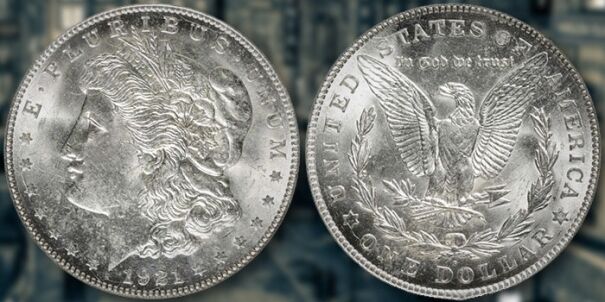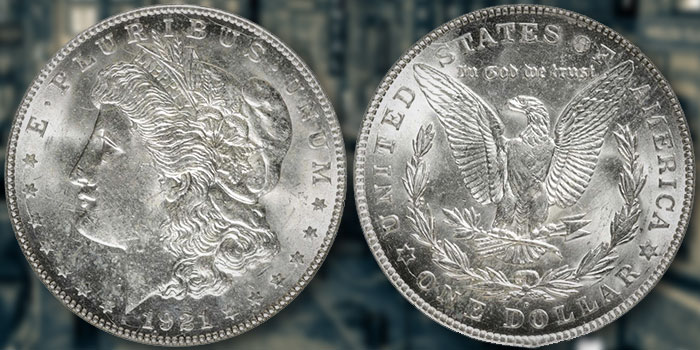
By Charles Morgan and Hubert Walker for CoinWeek Notes …..
Suspended in 1904 due to a significant drop in the demand for silver resulting from the passage of the 1890 Sherman Silver Act, no further Morgan Dollars would be struck until 1921. The series was thought to be dead.
Yet because of World War I, the government of Great Britain was facing an economic crisis. Senator Key Pittman of Nevada proposed that the United States melt a portion of its reserves, held in silver coins, to help prevent the British pound from crashing, especially in India. The eponymously named Pittman Act of 1918 ordered that up to 350 million silver dollars be melted and sold to England at an artificially low fixed rate of one dollar per ounce. This was quite the diplomatic favor, since during 1918, the spot price of silver fluctuated between $17 and $20.
While Britain did not purchase their full allotment, the US did melt some 270,232,722 silver dollars – the vast majority being Morgan Dollars. This accounted for nearly half of the total mintage of Morgan Dollars struck from 1878 up to and including 1904. However, the Pittman Act also mandated that the US strike a replacement silver dollar for every coin they melted. Hence, the silver dollar was brought back in 1921.
But because the 1921 Peace Dollar design was not yet finalized, they were forced to restart the Morgan Dollar series.
Unfortunately, Mint officials had assumed that the Morgan series was dead, and so they had destroyed the master dies in 1910. So the Mint was forced to create an entirely new master die for the 1921 Morgan Dollars. This new die, however, came out slightly different than previous Morgan Dollar dies. The now 76-year-old George T. Morgan re-engraved Lady Liberty’s head as smaller, very slightly thinner, and slightly younger. His new design also had slightly less relief than the earlier version and lacked some details on the designs’ highest points.
The high demand for dollar coins created by the Pittman Act forced the United States Mint to strike a record number (86,730,000 coins) of Morgan Dollars in 1921. The lions’ share (44,690,000 coins) was struck in Philadelphia.
What Is the 1921 Philadelphia Morgan Dollar Worth?
PCGS Coinfacts estimates that there are 13,500 examples surviving in MS65 or better, of which they have certified 7,828 examples. Additionally, NGC has certified 10,852 pieces in 65 or better. The highest certified grade for both companies is MS67+.
Because of the large mintage in 1921, which accounts for over 13% of the entire series, low-grade examples are priced just above the spot rate for silver. Since silver is worth just over $25 per ounce at the time of writing, low-grade 1921-P Morgan Dollars are worth approximately $27 to $30. At $30 to $40, mid-grade examples (XF to low AU) are worth slightly more. In low Mint State (MS60 to 62), the 1921 Morgan is worth between $50 and $90. In high Mint State, prices really start to climb; between MS65 and MS66, the value jumps from roughly $200 to upwards of $2,000. An MS67, sold in the Legend Rare Coin Auctions October 2015 sale, set the current auction record of $19,975.
* * *
Market Data and Noteworthy Specimens
The PCGS MS67 population includes one coin graded MS67PL. The PCGS MS67 population has grown from 10 to 34 coins since July 2015. The NGC census indicates one coin at MS67+. That coin (#4752096-005) was submitted to PCGS and downgraded to MS67.
Top Population: PCGS MS67 (34, 2/2025), NGC MS67 (27, 2/2025), and CAC MS67 (5:0 stickered:graded, 2/2025).
- PCGS MS67 #36186941: As PCGS MS67 #05700174. “The R. Dier Collection”, Heritage Auctions, January 7, 2004, Lot 2131 – $12,075; “The Jackson Hole Collection,” Heritage Auctions, April 9, 2007, Lot 117 – $12,650. Pop 11 when offered. As PCGS MS67 #36186941. “Gold River Collection”; Heritage Auctions, January 17, 2025, Lot 5301 – $12,000.
- PCGS MS67 CMQ #50852409: Stack’s Bowers, November 19, 2024, Lot 3076 – $8,400. Streak of golden brown toning across hair and jaw. Diagonal scratch on chin. Cut to the left of star 8. Scattered stains on the reverse.
- PCGS MS67 #49105500: Stack’s Bowers, August 13, 2024, Lot 3253 – $8,400. Brilliant.
- PCGS MS67 #38383753: Stack’s Bowers, March 19, 2020, Lot 3212 – $8,400; Stack’s Bowers, August 6, 2020, Lot 1242 – $9,000. Scattered light golden toning. Diagonal cut below eagle’s right wing. Pop 18 when offered.
- PCGS MS67 #35926210: As NGC MS67+ Heritage Auctions, February 20, 2020, Lot 3127 – $13,200. As PCGS MS67 #35926210. Stack’s Bowers, October 25, 2018, Lot 2103 – $15,500 Reserve Not Met. PCGS downgraded 1/2 point. PQ obverse toning.
- NGC MS67 #697051-003: Stack’s Bowers, October 25, 2018, Lot 1110 – $5,040. Scattered golden toning along the obverse periphery.
- PCGS MS67 #83560929: Heritage Auctions, August 2, 2017, Lot 4059 – $9,987.50. Darkly toned.
- NGC MS67 #3817059-003: Stack’s Bowers, May 25, 2016, Lot 55 – $6,462.50.
- PCGS MS67 #25231484: Stack’s Bowers, July 2015, Lot 4629 – $11,750. Champagne hue. Scattered brown toning along date and right-side rim. Toning spot between stars 10 and 11. Toning spot on cheek. Pop 10 when offered.
- PCGS MS67 #25353559: Heritage Auctions, January 9, 2014, Lot 5331 – $15,862.50. Brilliant. Pop 8 when offered.
Design
Obverse:
The obverse of the 1921-P Morgan Dollar exhibits the characteristic left-facing Liberty Head motif seen on all issues of this classic dollar series. The central Liberty bust wears a Phrygian cap encircled with a ribbon adorned with the inscription LIBERTY. Miss Liberty also wears a crown of wheat and cotton, which were two of the nation’s most lucrative natural agricultural assets in the 19th century.
The motto E PLURIBUS UNUM is inscribed along the upper half of the obverse rim, and the date 1921 is centered at the bottom of the obverse adjacent to the rim. Seven stars appear between the left side of the date and the inscription E PLURIBUS UNUM, while six stars fill the gap between the date and motto on the lower right side of the coin. In total, the 13 stars symbolize the 13 colonies that combined to form the original Union of the United States. At the base of Liberty’s neck is the M monogram representing Morgan’s initial.
Morgan designed the Liberty head bust after the likeness of Anna Willess Williams, a Philadelphia schoolteacher who modeled for the coin. Williams received significant public recognition after her face appeared on the Morgan Dollar, but she rejected the attention that was heaped upon her. She refused offers for acting roles and apparently had turned down an offer for marriage following her engagement to an unknown suitor. Before dying at the age of 68 in 1926, Williams, who sat for Morgan on the sworn condition of anonymity, rebuffed her single stint as a coin design model as little more than an “incident of my youth.”
Reverse:
The reverse of the 1921 Morgan Dollar is dominated by a heraldic eagle, its wings spread across the upper half of the coin. Between the upper tips of the eagle’s wings appears the motto IN GOD WE TRUST. The eagle clutches an olive branch in its right claw representing peace and in its left claw are three arrows symbolizing the nation’s ability to defend itself. The central eagle design is partly encircled by a laurel wreath.
Along the rim of the upper two-thirds of the reverse is the legend UNITED STATES OF AMERICA, with the tip of the eagle’s left wings, which virtually touch the coin’s rim, interrupting the space between UNITED and STATES; the right wing visually divides the words OF and AMERICA. The words ONE DOLLAR, seen at the bottom center of the reverse, are flanked by a single, six-sided star on either side of the denomination inscription. Since the coin was struck in Philadelphia, there is no mint mark.
Edge:
The edge of the 1921 Morgan Dollar is reeded.
Designer
Engraver George T. Morgan was born in Birmingham, England in 1845. He emigrated to the United States and began work as an assistant to Mint Chief Engraver William Barber and continued to produce patterns and commemoratives under the administration of Barber’s son, Charles. Morgan himself became Chief Engraver in 1917. He died in 1925.
Coin Specifications
| Country: | United States of America |
| Year of Issue: | 1921 |
| Denomination: | One Dollar (USD) |
| Mintmark: | None (Philadelphia) |
| Mintage: | 44,690,000 |
| Alloy: | .900 silver, .100 copper |
| Weight: | 26.73 g |
| Diameter: | 38.10 mm |
| Edge: | Reeded |
| OBV Designer: | George T. Morgan |
| REV Designer: | George T. Morgan |
| Quality: | Business Strike |
* * *


